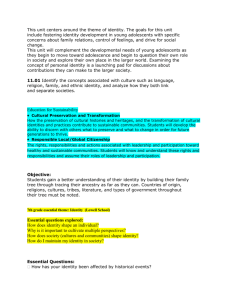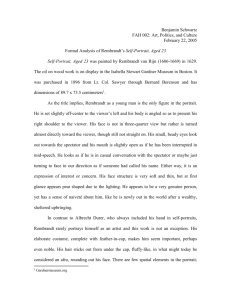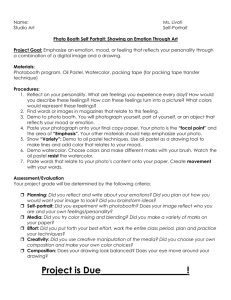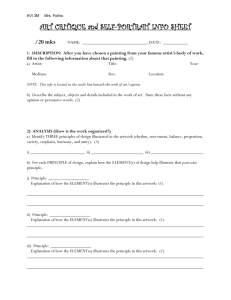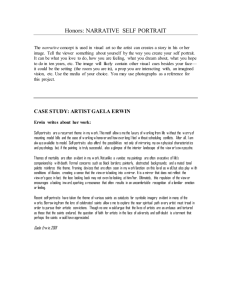Self-Portrait-Autobiography
advertisement
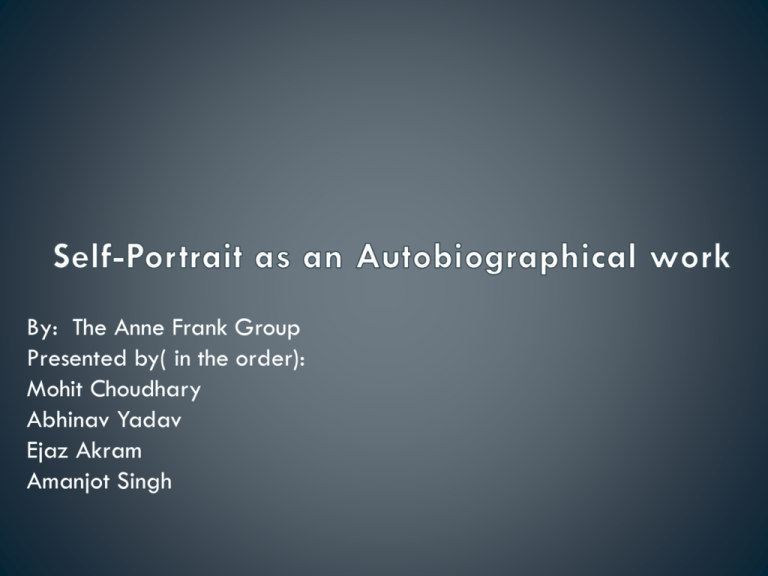
By: The Anne Frank Group Presented by( in the order): Mohit Choudhary Abhinav Yadav Ejaz Akram Amanjot Singh • A self-portrait is a representation of an artist, drawn, painted, photographed, or sculpted by the artist. artist-model must alternately pose and paint. • The artist works from memory as well as sight, in two levels of time, on two planes of space, while reaching for those other dimensions, depth and the future. • Although self-portraits have been made by artists since the earliest times, it is not until the Early Renaissance in the mid 15th century that artists can be frequently identified depicting themselves as either the main subject, or as important characters in their work. • With better and cheaper mirrors, and the advent of the panel portrait, many painters, sculptors and printmakers tried some form of self-portraiture. • Portrait of a Man in a Turban by Jan van Eyck of 1433 may well be the earliest known panel selfportrait. Raphael, c. 1517-1518, Uffizi Gallery Leonardo da Vinci( 1512)- Self-Portrait • A self-portrait may be a portrait of the artist, or a portrait included in a larger work, including a group portrait. • In the earliest surviving examples of medieval and renaissance self-portraiture, historical or mythical scenes (from the Bible or classical literature) were depicted using a number of actual persons as models, often including the artist, giving the work a multiple function as portraiture, selfportraiture and history/myth painting. • Ex: Rubens's The Four Philosophers (1611–12) Rubens's The Four Philosophers • In the famous Arnolfini Portrait (1434), Jan van Eyck is probably one of two figures glimpsed in a mirror a surprisingly modern conceit. • In what may be one of the earliest childhood self-portraits now surviving, Albrecht Dürer depicts himself as in naturalistic style as a 13-year old boy in 1484. In later years he appears variously as a merchant in the background of Biblical scenes and as Christ In the 17th Century, Rembrandt painted a range of self-portraits. In The Prodigal Son in the Tavern (c1637), one of the earliest self-portraits with family, the painting probably includes Saskia, Rembrandt's wife, one of the earliest depictions of a family member by a famous artist. Family and professional group paintings, including the artist's depiction, became increasingly common from the 17th Century onwards. • Portraits and self-portraits have a longer continuous history in Asian art than in Europe. • Many in the scholar gentleman tradition are quite small, depicting the artist in a large landscape, illustrating a poem in calligraphy on his experience of the scene. • Another tradition, associated with Zen Buddhism, produced lively semi-caricatured self-portraits, whilst others remain closer to the conventions of the formal portrait. Hakuin Ekaku was a Zenmonk, who painted Miyamoto Musashi, Samurai, writer and artist, c. many self-portraits of himself as sages of 1640. the past, 1764, Tokyo. Motoori Norinaga, late 18th century, Japan Rabindranath Tagore, self portrait • Illuminated manuscripts contain a number of apparent selfportraits, notably those of Saint Dunstan and Matthew Paris • Orcagna is believed to have painted himself as a figure in a fresco of 1359, which became, at least according to art historians - Vasari records a number of such traditions- a common practice of artists. • Benozzo Gozzoli includes himself, with other portraits, in the Palazzo Medici Procession of the Magi (1459), with his name written on his hat. Benozzo Gozzoli Saint Dunstan, then artist-Abbot of Glastonbury, Peter Parler, late fourteenth century, from Prague Cathedral, where he was prostrates himself before a giant Christ. Later master architect and sculptor he became Archbishop of Canterbury. c. 950 Lorenzo Ghiberti on the Gates of Paradise, Baptisterio, Florence self portrait, early 15th century Jean Fouquet, c. 1450, a very early portrait miniature, and if the Van Eyck above is excluded, the oldest individual Western painted self-portrait. • The great Italian painters of the Renaissance made comparatively few formal painted self-portraits, but often included themselves in larger works. • Most individual self-portraits they have left were straightforward depictions: Gentile Bellini, black chalk, 1496 or earlier, Berlin Nuremberg sculptor Adam Kraft, self-portrait from St Lorenz Church, 1490s. Probable self-portrait byLeonardo da Vinci, c. 1512-1515 Nicholas Hilliard, self-portrait miniature, 1577 • In the 17th century, Flemish and Dutch artists painted themselves far more often; by this date most successful artists had a position in society where a member of any trade would consider having their portrait painted. • Rembrandt was the most frequent self-portraitist, at least until the self-obsessed modern period, also often painting his wife, son and mistress. At one time about ninety paintings were counted as Rembrandt self-portraits, but it is now known that he had his students copy his own self-portraits as part of their training. • His self-portraits form a unique and intimate biography, in which the artist surveyed himself without vanity and with the utmost sincerity. A young Rembrandt, c. 1628, when he was 22. Partly an exercise in chiaroscuro.Rijksmuseum Rembrandt in 1632, when he was enjoying great success as a fashionable portraitist in this style. 1640, wearing a costume in the style of over a century earlier. National Gallery Dated 1669, the year he died, though he looks much older in other portraits. National Gallery, London • One of the most famous and most prolific of self-portraitists was Vincent van Gogh, who painted himself thirty-seven times between 1886 and 1889. • The many self-portraits of Egon Schiele set new standards of openness, or perhaps exhibitionism, representing him naked. Vincent van Gogh, Self Portrait, dedicated to Gauguin, 1888 • Throughout his long career, Pablo Picasso often used selfportraits to depict himself in the many different guises, disguises and incarnations of his autobiographical artistic persona. Picasso's self portraits depicted and revealed complicated psychological insights, both personal and profound about the inner state and well being of the artist. • Another artist who painted interestingly personal and revealing self-portraits throughout his career was Pierre Bonnard. Bonnard also painted dozens of portraits of his wife Marthe throughout her life as well. picasso self portrait 1907 Pierre Bonnard- Self Portrait Painters at work: • Many of the medieval portraits show the artist at work, and Jan van Eyck his chaperon hat has the parts normally hanging loose tied up on his head, giving the misleading impression he is wearing a turban, presumably for convenience whilst he paints. In the early modern period, increasingly, men as well as women who painted themselves at work had to choose whether to present themselves in their best clothes, and best room, or to depict studio practice realistically. Pieter Brueghel the Elder, The Painter and The Buyer, c.1565, pen and ink on brown paper, presumed to be a selfportrait. Antwerp Francesco Solimena, c. 1715. François Boucher, self-portrait in the studio, 1720 Self-portrait c.1747-9 by Joshua Reynolds • The self-portrait supposes in theory the use of a mirror; glass mirrors became available in Europe in the 15th century. The first mirrors used were convex, introducing deformations that the artist sometimes preserved. A painting by Parmigianino in 1524 Self-portrait in a mirror, demonstrates the phenomenon • this use of the mirror often results in right-handed painters representing themselves as left-handed (and vice versa). Usually the face painted is therefore a mirror image of that the rest of the world saw, unless two mirrors were used. Most of Rembrandt's self-portraits before 1660 show only one hand - the painting hand is left unpainted.[27] He appears to have bought a larger mirror in about 1652, after which his self-portraits become larger. In 1658 a large mirror in a wood frame broke whilst being transported to his house; nonetheless, in this year he completed his Frick self-portrait, his largest. Parmigianino Selfportrait Johannes Gumpp, 1646, shows how most self-portraits were painted Michelangelo Buonarroti, circa 15351541, Sistine Chapel: The Last Judgment, Michelangelo as a limp skin hanging from the hand of St. Bartholomew. Allegory of Prudence, Titian, his son and the cousin he had virtually adopted, as Past, Present and Future. National Gallery, London, late 1560s. • the self-portraits of many Contemporary artists and Modernists often are characterized by a strong sense of narrative, often but not strictly limited to vignettes from the artists life-story. Sometimes the narrative resembles fantasy, role-playing and fiction. Cristofano Allori, Judith with the Head of Holofernes, 1613. According to his biographer, the heads were those of the painter, his exlover, and her mother. Compare Caravaggio above Gustave Courbet, 1854,Bonjour, Monsieur Courbet. The artist has travelled to the South of France (in the vanishing coach), to meet the collector Alfred Bruyas, for whom this was painted François Desportes, a specialist animal painter,Self-portrait as Hunter, 1699. Gustave Courbet, Self Portrait (The Desperate Man), c. 1843. • Two methods of obtaining photographic self-portraits are widespread. One is photographing a reflection in the mirror, and the other photographing one's self with the camera in an outstretched hand. Eleazar Langman photographed his reflection on the surface of a nickel-plated teapot. • Another method involves setting the camera or capture device upon a tripod, or surface. One might then set the camera's timer, or use a remote controlled shutter release. Mathew Brady, self-portrait, circa 1875 Nadar, Revolving Self Portrait,c. 1865 Eleazar Langman, Self-portrait, 1935 Akihiko Hoshide taking a self-portrait during extravehicular activity outside the International Space Station 1. Campbell, Lorne; National Gallery Catalogues (new series): The Fifteenth Century Netherlandish Paintings, pp 212-17, 1998, ISBN 1-85709-171-X 2. Accessed online July 28, 2007 an online history of self-portraits, various excerpts from Edward Lucie-Smith and Sean Kelly, The Self Portrait: A Modern View(London: Sarema Press, 1987) 3. "Albrecht Dürer and his Legacy: The graphic work of a Renaissance artist". New York: Studio International Magazine. March 2003. Retrieved 2010-08-08. 4. Erwin Panofsky (and originally Fritz Saxl), Titian's "Allegory of Prudence", A Postscript, in Meaning in the Visual Arts, Doubleday/Penguin, 1955 5. For this section and the gallery, Ernst van de Wetering in Rembrandt by himself, p.10 andassim, 1999, National Gallery, London/Mauritshuis, The Hague, ISBN 185709-270-8 6. Encyclopedia of Irish and World Art, art of self-portrait Retrieved June 13, 2010 7. Rembrandt by himself, op cit, pp 11-13; for the Arnolfini reference see: National Gallery Catalogues (new series): The Fifteenth Century Netherlandish Paintings, Lorne Campbell, 1998, ISBN 185709171 8. And Special contribution to wikipedia.org and Google Image Search. Leonardo Da Vinci, Self-portrait, c. 1512 to 1515. William Morris, self portrait, 1856
